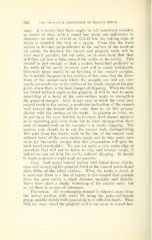Page 684 - My FlipBook
P. 684
342 THE TECHNICAL PBOCEDUEES IN FILLING TEETH.
inlay. It is better tliat these angles be left somewhat rounded,
as would be done with a round bur about one millimeter in
diameter, or with a 12-5-12 or 12-5-23 hoe, the cutting edge of
which is rounded like that of a spoon. From this the walls
should be finished perpendicular to the surface of the tooth at
all points. So finished, the incisal and gingival walls will be
very nearly parallel, but not quite, or in such form that they
will flare out just a little toward the orifice of the cavity. This
should be just enough so that a matrix burnished perfectly to
the walls of the cavity in eveiy part will be easily withdrawn.
Generally there should be no beveling of the enamel margins,
for it usually happens in the cavities of this class that the direc-
tions of the enamel rods where the margins are laid are very
nearly perpendicular to the surface of the tooth, except at the gin-
gival, where there is the least danger of chipping. When the rods
are found inclined much to the gingival, it will be best to make
something of a bevel of the cavo-surface angle to strengthen
the gingival margin. Also, in any case in which the inlay may
extend much to the incisal, a moderate inclination of the enamel
wall toward the incisal will be safer than to cut this perpen-
dicular with the surface of the tooth. In placing an inlay, we
do not incur the same liability to fracture frail enamel margins
as in malleting gold over them, but to leave unsupported short
ends of enamel rods on the margins is to invite chipping. The
general rule should bo to cut the enamel wall, distinguishing
this part from the dentin wall, in the line of the enamel rods
without bevel of the cavo-surface angle and to take great care
to so lay the cavity margin that this preparation will give the
least bevel practicable : We can not make a very acute edge of
porcelain that will not be liable to chip and become rough, if
indeed we can set it in the cavity without chipping. It should
be made as nearly a right angle as possible.
Case. Left upper central incisor with labial decay. Cavity
open and occupying the gingival third of the central mesio-distal
three-fifths of the labial surface. When the tooth is dried, it
is seen that there is a line of injury to the enamel that extends
from the open cavity a slight distance mesially and distally.
These lines show a chalky wliitening of the enamel only; but
as yet there is no loss of substance.
Procedure. All overhanging enamel is chipped away from
the incisal portion with chisel 10, using the palm-and-thumb
grasp, and the dentin wall squared up to a sufficient depth. Then
with the same chisel the gingival wall is cut away to sound den-


